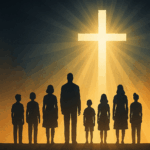“New Testament Giants of the Faith – John” – John 10:22-30
1. John: The disciple that Jesus loved
Today, we are continuing a short series of sermons on New Testament Giants of the Faith. We have already heard about Thomas, the doubting, but honest disciple, and about Paul, the persecutor of Jesus turned proclaimer of Jesus. Today, we turn our attention back to the circle of disciples as we consider John. So, who was John?
We do hear and learn quite a bit about John in the Gospels. We know about his family – that his father’s name was Zebedee and that his mother’s name was Salome. His brother James was also a disciple of Jesus. John’s name is usually mentioned second, so he was probably the younger brother. There are two other hints that John was a young disciple: first, when he and Peter were racing to Jesus’ tomb on Easter Sunday, John got there ahead of Peter… a signal that he was younger, faster; second, John’s authorship of his three letters and the Book of Revelation, and their dating in the late first century, indicate that John lived well into his 80’s, maybe even his 90’s. So, he was probably in his 20’s when he followed Jesus.
John, along with his father and brother, were fishermen in or near Capernaum, on the Sea of Galilee, and in that fishing venture, we learn that they were partners with Peter and Andrew. In fact, it was there, on the shores of Galilee, that James and John were called to discipleship. We read that they left their nets, their boats, their father and the hired men to follow Jesus. The reference to ‘hired men’ indicates that the Zebedee family had wealth. Not many families would have had the means to hire men for their livelihood.
Not only was John one of the disciples mentioned first in the listing of disciples, but he was also one of the inner circle of 3 – Peter, James, John. They were the only disciples who went in with Jesus when He raised the dead daughter of Jairus. They were the only disciples who accompanied Jesus up the mount of Transfiguration. They were the only disciples that Jesus invited farther when He was praying in Gethsemane on Maundy Thursday evening.
One more thing of note with respect to John’s identity is that he is referred to as the disciple whom Jesus loved. That was actually John’s secret way of referring to himself anonymously and several times in his own Gospel account of Jesus’ life. John and Jesus must have had a special relationship.
2. John: Prolific New Testament writer
Another aspect of who John was is the fact that he was a prolific writer of the New Testament. He wrote one Gospel account of the life, death and resurrection of Jesus, and 3 letters that bear his name, and the last book of the Bible, Revelation. Those 5 books are second only to St. Paul (who is credited with writing 13 letters).
Only in that book of Revelation does John identify himself by name. His second and third letters come from someone simply identified as the “elder.” His first letter is anonymous, but indications are that the author was a personal companion of Jesus. In the Gospel, the author is not named, but several times that phrase “the disciple whom Jesus loved” seems to point to John.
3. Unique Features
a. Personal interest stories
There are several features of John’s writing, especially his Gospel account of Jesus’ life and ministry, that are unique. Matthew’s, Mark’s and Luke’s accounts of Jesus’ life and ministry are quite similar. Because they look at Jesus’ ministry with the same point of view, they are called ‘synoptics’ – literally a “seeing all together” or “seeing with the same eyes.” Those three accounts of Jesus are descriptive with a fairly fast-moving pace, and dialog, and teaching. They include roughly the same stories, often with almost a word-for-word similarity.
In contrast, John’s Gospel spotlights a few almost chapter-long personal interest stories.
In John 3, Jesus has a long night-time conversation with Nicodemus, a Pharisee with questions. They talk about the Kingdom of God, and how you can only see the Kingdom of God if you are born again of water and the Spirit. The conversation moves to a place where Jesus compares Himself to the Old Testament snake on a pole. Just as looking at that lifted-up snake provided healing for snake-bitten Israelites, so looking at Jesus lifted up on the cross provides spiritual healing and forgiveness for sin-bitten people. Then Jesus launches into (and John records) arguably the most well-known verse in the entire Bible: “God so loved the world that He gave His one and only Son, that whoever believes in Him shall not perish but have eternal life.”
In John 4, for some reason, Jesus goes through the ordinarily avoided land of Samaria, and asks a Samaritan woman for a drink of water from Jacob’s well at Sychar. They engage in some conversation about the oddness of Jesus asking for water from a Samaritan woman, and that leads Jesus to talking to her about the water that He can give… living water that quenches spiritual thirst and that wells up to eternal life. When the woman expresses a longing for that kind of water, they talk about the poverty of her failed marriage relationships. She changes the subject to talk about the right place to worship, which leads to a mention of the Messiah, and Jesus’ revelation that, in fact, that’s who He is. The woman, who is generally shunned by the townspeople for her shady relationship situation, becomes a missionary and tells her former adversaries that she thinks she has met the Messiah. In a matter of hours, she moves from being a socially ostracized woman to a woman who seems to be “all in” for Jesus.
John 9 tells another story – a “lived-out-parable” – of a MAN this time who was excluded from society. He had been born blind and would beg for his very existence. Jesus had compassion on him, put some saliva-mud on his eyes, and told him to go wash in the Pool of Siloam. The blind man went and washed and came home seeing. Because the day of his healing was a Sabbath, the Pharisees felt they needed to write up an “incident report” with all the details about what had happened. They questioned the blind man, and then his parents, then the blind man again. During the course of that day, the former blind man not only had his physical sight restored but also had his spiritual sight restored as he moved from calling Jesus “the man” to “a prophet” to being “from God” finally to calling Him “Lord” – believing in Him and worshiping Him.
One more chapter-long account is found in John 11. As the story begins, a man named Lazarus is sick. He must have been a good friend of Jesus, or maybe even a relative, for his sisters sent word to Jesus saying, “The one you love is sick.” Jesus delayed his departure for a couple of days, and we hear some of the discussion about that between Jesus and His disciples, with His disciples fearing for Jesus’ very life. When Jesus was finally ready to go to Bethany (near Jerusalem), it was Thomas who said, “Let us also go, that we may die with Him.” We heard about that Thomas-statement two weeks ago. By the time Jesus arrived, Lazarus had died and was already in the tomb for four days. He greeted and comforted the older sister Martha with His powerful words, “I AM the Resurrection and the Life. Whoever believes in me will live, even though he dies.” Then, going into town, He greeted and comforted Mary, the younger sister and He even wept with those sisters, showing His great compassion for them in their grief. Finally, He went to the tomb, asked them to take away the stone, and called Lazarus to come out. When Lazarus did come out still wrapped in the strips of linen, Jesus had backed up His “I AM the Resurrection and the Life” words with true and meaningful and authoritative action.
b. Jesus’ “I AM Statements”
That John 11 account leads us to another unique feature of John’s gospel. In some of those stories, and in other teaching occasions, Jesus used seven profound statements / picture images to connect Himself with the “I AM” God of the Old Testament. None of the other gospel writers record these statements.
In John 6, after recently feeding a crowd of 5,000 or more with five loaves of bread and two fish, Jesus boldly proclaims “I AM the Bread of Life.” People would naturally have had their thoughts taken back to that multiplying bread miracle. But like the living water conversation with the Samaritan woman, Jesus was here saying that His intent and purpose is not just to fill people’s tummies, but to satisfy the hunger of their hearts with Himself and His grace.
In John 8, Jesus says, “I AM the Light of the World. Whoever follows me will never walk in darkness, but will have the light of life.” That saying was repeated in the prologue to the John 9 account of the man born blind. He truly experienced Jesus as the new light of his life. He could see both physically and spiritually.
In John 10, Jesus offers two “I AM” statements in the context of the same conversation. He is talking about God’s people using the Old Testament image of sheep. First, He says “I AM the gate for the sheep,” and that they can come in and go out and find pasture. [Some Bible translations say “I AM the door of the sheep,” but it is the same picture.] He is saying that He is the one through whom people have a full and abundant and eternal life. In the second and complementary image, Jesus says, “I AM the good shepherd.” This is a picture of Jesus’ care for and protection of His sheep, His people, and He even goes farther to affirm that He will lay down His life for His sheep.
In John 11, we have already heard Jesus say, “I AM the Resurrection and the Life.” His raising of Lazarus showed that He did, indeed, have power over death itself, and by His own resurrection He would prove that He could reverse the damning effects of death for all of us. We still can anticipate with joy the fulfilling of those very words for us, for God is always faithful in keeping His promises.
In John 14, we hear another Thomas question, which prompted an “I AM” response from Jesus. Jesus had encouraged His disciples not to be worried and troubled, for He was going to prepare a place for them and He promised to come back and take them to be with Him. Thomas said they don’t even know the place so how can they know the way. In reply, Jesus said, “I AM the Way, and the Truth, and the Life. No one comes to the Father except through me.” He was saying that, if you want to get to the Father, and the Father’s house, He, Himself, is the road, the only road, and the sure road that leads there. The disciples could be confident of that. We can be confident of that.
The seventh and last “I AM” statement of Jesus is found in John 15. There, Jesus uses a horticultural image as He says, “I AM the Vine; you are the branches. If a man remains in me and I in Him, he will bear much fruit; apart from me you can do nothing.” Jesus was stressing the importance of staying connected with Him – in prayer, in His Word. A branch can’t bear ripe grapes unless it stays connected with the vine which provides the nutrients for proper growth. Several times in those few verses, Jesus emphasizes the bearing of fruit, fruit that will last. That will only happen as we are deeply and firmly connected with His life-giving sustenance.
Those are the seven “I AM” sayings, but there are actually a few more lesser-known bonus “I AM” sayings of Jesus. In John 4, the Samaritan woman says that when the Messiah comes, he will explain everything. Jesus replied, “I AM.” In John 6, when Jesus came walking to the disciples on water, He dispelled their fear by saying, “I AM.” In John 8, in a discussion with some Jews about their Abraham heritage, Jesus asserts, “Before Abraham was born, I AM.” And in John 18, when Jesus was being arrested by the soldiers, He affirmed His own identity saying simply, “I AM.”
So, we have all those amazing sayings of Jesus, (and the bonus ones) with thanks to disciple John… and with REAL thanks to the Holy Spirit through John.
[Excursus: John’s black marks – oops!!]
So far, John fits the bill of a bona fide giant of faith: the disciple whom Jesus loved, the prolific writer of New Testament books, the personal interest stories, and the “I AM” sayings of Jesus. Did you know that John wasn’t perfect? Did you know that John actually has some black marks against him in the Gospels? We don’t hear about any of John’s black marks from his own Gospel story. That would be too much to ask. None of us likes to hang out our own dirty moral laundry. But Mark and Luke tell us the truth.
In Mark 10, we hear John, along with his brother James, ask Jesus for a special favour – to have the brothers sit at his right hand and at his left hand in the final kingdom. That was a request of pride and ambition. We want to be the best, we want to have the places of honour. It’s no surprise that the other disciples were upset with John and James when they heard about their request. (Maybe they were mad because they didn’t think of it first, kind of like when someone pipes up, “I’m riding shotgun!” You’re upset that you didn’t say it first.) And it’s also no surprise that Jesus set them all straight, explaining that whoever wants to be great must actually become a servant, and then He pointed out that He, Himself came to serve and to give His life as a ransom for many.
In Luke 9, we hear another little story prompted by an argument about greatness among the disciples. Jesus puts the final word on that discussion by saying, “Whoever welcomes this little child in my name welcomes me.” Then John, protecting their exclusive status as disciples, tells Jesus about another man, not one of the Twelve, who was casting out demons in Jesus’ name, and he proudly said, “We stopped him from doing that.” Jesus scolded John for that attitude, saying that “whoever is not against you is for you.”
A few verses later, they passed through a village where the people didn’t welcome Jesus. With a bitter and vengeful attitude, John (and James, too) asked Jesus if they should call down fire / thunder from heaven to destroy those inhospitable people. Once again, Jesus scolded the brothers for their anger. This episode either resulted in them being known as the “Sons of Thunder” or gave evidence of them BEING the “Sons of Thunder.”
It’s good to hear about those black marks of John, because it makes him real, human, sinful, just like we are. But there’s one more thing to hear about John…
c. Love!!
Another unique feature of John’s writings is his emphasis on love. John’s first letter talks A LOT about love. In just 5 short chapters and 105 verses, we hear John use the verb “to love” 26 times, and the noun “love” 18 times, and the adjective “beloved” 5 times. In the 27 combined verses of 2 and 3 John, those “love” words are used another 10 times. The Book of Revelation, in its images of the final spiritual battle, doesn’t have so many occurrences of the words for “love” but one notable mention is when Jesus scolds the church in Ephesus for having lost their first “love” – their love for Him.
When we turn to John’s Gospel and the words and events of Jesus’ ministry, we find 7 occurrences of the noun “love,” and the verb “to love” is found in some form 35 times. Some of the memorable ones are: the connection of loving Jesus with the keeping of His commands; the Maundy Thursday new command to love one another; and Jesus’ post-resurrection inquiries about Peter’s love for Jesus.
But by far the most memorable references to love are about God’s love for us and how that was shown. Yes, after talking about the Son of Man being lifted on a pole like the snake in the desert, there’s that famous John 3:16 – “God so loved the world, God so loved YOU, that He gave His one and only Son, for YOU, that whoever believes in Him, if YOU believe in Him, you shall not perish but have eternal life.” But equally significant and equally personal is John 14:13 – “Greater love has no one than this, that he lay down his life for his friends.” And that’s exactly what Jesus did for His disciple-friends, and for YOU! He laid down His life out of great love for YOU!
John, today’s New Testament Giant of the Faith has made this clear for us. God is full of love for you! As you fit yourself into any one of those personal-interest stories, as you listen to Jesus’ “I AM” statements and what they mean, they ALL reveal God’s love for you. That was John’s intent as he wrote about Jesus for our learning, for our faith. He wanted us to know God’s love. He wanted to live God’s love. So, we close with one more memorable verse from 1 John 4 – “We love…. Because He first loved us.” Amen.









